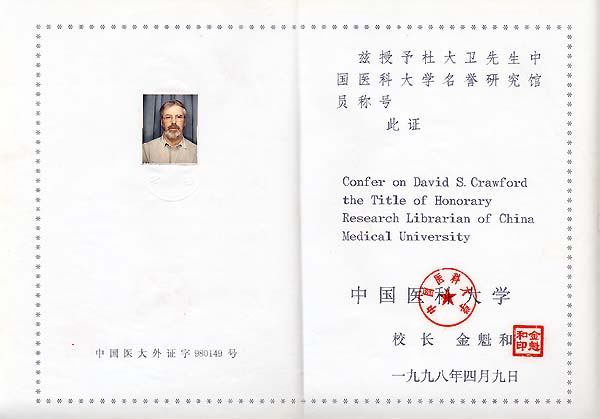
Return to David Crawford's Home Page

The China Medical University (CMU) was the first medical school established by the Chinese Communist Party. Its precursor was the Chinese Workers’ - Peasants’ Red Army Military Medical School and Chinese Workers’ - Peasants’ Red Army Health School which had been founded in Ruijin city, Jiangxi province, in 1931. After the Long March with the red army, it moved to Shanbei. In 1940 comrade Mao Zedong proposed, and the central committee of the Chinese Communist Party approved, the name of the school being changed to China Medical University. In July 1946 the university was ordered to enter north-east China with the army and reached Xinshan city - now Hegang city - Heilongjiang province. In November/December 1948 the whole north-east of China was liberated and the university was ordered to move to Shenyang. In 1948 and 1949 it absorbed the medical school formerly operated by the (Japanese) South Manchurian Railway Company (the South Manchuria Medical College, later called the Shenyang Medical College and the Nan Man Medical College, which had opened in 1911) and the Mukden Medical College - sometimes spelled Moukden Medical College- also opened as a stand-alone institution in 1911.) Shortly before it was absorbed the name of the Mukden Medical College was changed to Liaoning Medical College. (Historical information on CMU taken from, and more information available at:: http://www.cmu.edu.cn/. As described in "A brief History of Mukden Medical College - Fengtian yi ki da xue", published in Shenyang in 1992, the Mukden Medical College grew out of the Mukden Hospital (now the Sheng Jing Hospital) , both of which were founded by Dr Dugald Christie, a Scottish missionary doctor, whose son, Ronald, later became Dean of Medicine at McGill University in Montreal. Dr. Christie, who was supported by the Edinburgh-based United Presbyterian Church, opened a 12-bed hospital in Mukden (now called Shenyang) in 1883. Once this hospital was established a few young men were enrolled as apprentices and, after three years of study, they were given certificates as medical assistants, pharmacists or nursing aides. In 1892 eight young men were enrolled for a 5-year program and a preliminary medical school, Sheng Jing Medical School, was established. After considerable effort by Dr. Christie and his colleagues and after many set-backs due to war, invasion and lack of money, this developed into a more formal medical school. In 1911 a four-story building was completed and the new College opened, as the Mukden Medical College (MMC), and accepted its first students in 1912. Rev. Alexander Robert Crawford, an Irish missionary teacher based in North Eastern China from 1895 -1913 had been a strong supporter of this venture and his daughter, Agatha Randal Crawford, was appointed as professor of pathology at MMC in 1946; she remained there until 1949 when she, and most, foreign teachers left China. Partly due to these family connections, David Crawford was invited to visit CMU in 1986 as a library consultant. During this visit he signed an Agreement between McGill University and China Medical University. This Agreement ( English / Chinese ) is still in effect and four McGill staff members have visited CMU and several CMU staff have visited McGill. In 1998 David Crawford was appointed as Honorary Research Librarian at CMU ; he continues to maintain contact with both the Library and the School of Information Management and Information Systems (Medicine); he most recently visited CMU in October 2004. In 2010 the government agreed to move CMU on a new campus just outside the city; this opened in 2014. The main affiliated hospital remains in central Shenyang and will, apparently, expand onto the former CMU campus. See: Wikipedia Information on Sheng Jing Hospital. |

Return to David Crawford's Home Page
Latest update: February 2015